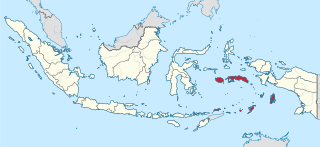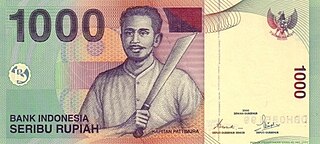Related Research Articles

Minangkabau is an Austronesian language spoken by the Minangkabau of West Sumatra, the western part of Riau, South Aceh Regency, the northern part of Bengkulu and Jambi, also in several cities throughout Indonesia by migrated Minangkabau. The language is also a lingua franca along the western coastal region of the province of North Sumatra, and is even used in parts of Aceh, where the language is called Aneuk Jamee.

Seram is the largest and main island of Maluku province of Indonesia, despite Ambon Island's historical importance. It is located just north of the smaller Ambon Island and a few other adjacent islands, such as Saparua, Haruku, Nusa Laut and the Banda Islands.

Saparua is an island east of Ambon Island in the Indonesian province of Maluku; the island of Haruku lies between Saparua and Ambon. The main port is in the south at Kota Saparua. The small and uninhabited island of Maolana is located near its southwestern side and Nusa Laut off its southeastern tip.
In addition to its classical and modern literary form, Malay had various regional dialects established after the rise of the Srivijaya empire in Sumatra, Indonesia. Also, Malay spread through interethnic contact and trade across the south East Asia Archipelago as far as the Philippines. That contact resulted in a lingua franca that was called Bazaar Malay or low Malay and in Malay Melayu Pasar. It is generally believed that Bazaar Malay was a pidgin, influenced by contact among Malay, Hokkien, Portuguese, and Dutch traders.

Maluku is a province of Indonesia. It comprises the central and southern regions of the Maluku Islands. The largest city and capital of Maluku province is Ambon on the small Ambon Island. It is directly adjacent to North Maluku, Southwest Papua, and West Papua in the north, Central Sulawesi, and Southeast Sulawesi in the west, Banda Sea, Australia, East Timor and East Nusa Tenggara in the south and Arafura Sea, Central Papua and South Papua in the east. The land area is 57803.81 km2, and the total population of this province at the 2010 census was 1,533,506 people, rising to 1,848,923 at the 2020 census, the official estimate as at mid 2023 was 1,908,753. Maluku is located in Eastern Indonesia.

Thomas Matulessy, also known as Kapitan Pattimura or simply Pattimura, was a famous Ambonese soldier who became a symbol of both the Maluku and Indonesian struggle for independence, praised by President Sukarno and declared a national hero by President Suharto. He has several namesakes in both the Netherlands and in the Indonesian archipelago.
The Piru Bay languages are a group of twenty Malayo-Polynesian languages, spoken on Ambon Island and around Piru Bay on the island of Seram, Indonesia. None of the languages have more than about twenty thousand speakers, and several are endangered with extinction.

Central Maluku Regency is a regency of Maluku Province of Indonesia. The Regency covers an area of 11,595.57 km2, and had a population of 361,698 at the 2010 Census, and 423,094 at the 2020 Census. The official estimate as at mid 2023 was 430,798. The principal town lies at Masohi, on Seram Island. The regency (kebupaten) is composed of the central part of the island of Seram, the Banda Islands, and the Lease Islands, together with those parts of Ambon Island which are outside the City of Ambon.
The Bima language, or Bimanese, is an Austronesian language spoken on the eastern half of Sumbawa Island, Indonesia, which it shares with speakers of the Sumbawa language. Bima territory includes the Sanggar Peninsula, where the extinct Papuan language Tambora was once spoken. Bima is an exonym; the autochthonous name for the territory is Mbojo and the language is referred to as Nggahi Mbojo. There are over half a million Bima speakers. Neither the Bima nor the Sumbawa people have alphabets of their own for they use the alphabets of the Bugis and the Malay language indifferently.
The Kingdom of Iha was an Islamic kingdom located in Saparua island, Maluku. Around the Dutch colonial period, there existed two well-known kingdoms in Saparua island, Iha and Honimoa. Both were quite influential Islamic empires known as sapanolua. This means two boat or two boats. It means Saparua island has two large peninsula thereon two ruling kings controlling a vast land. While the southeast peninsula was controlled by the King of Honimoa with his kingdom, the north peninsula was the regional power of the Kingdom of Iha. The Kingdom of Iha was involved in a series of struggles against the Dutch colonization of Maluku that later led to the Iha War (1632-1651) which resulted in a loss of some areas of this kingdom as well as its citizens which led to the later deterioration of the kingdom.

Bandung Berisik is a metal festivals in Indonesia. Founded by Bandung-based metal community Ujungberung Rebel and Homeless Crew. The festival's priority is to present bands across metal genres, based on underground scene popularity.

Haruku Island is an island in Central Maluku Regency, Maluku Province, Indonesia - lying east of Ambon Island, off the southern coast of Seram and just west of Saparua. It is administered as a single district, Haruku Island District, with a land area of 150 km2 and a population of 24,207 at the 2010 census and 27,390 at the 2020 Census; the official estimate as at mid 2023 was 26,551. The inhabitants of Haruku speak the Haruku language, as well as Indonesian and Ambonese Malay.
Nusa Laut is the smallest of the three inhabited island in the Lease Islands group situated east of Ambon Island, in Indonesia's Maluku province. It lies just off the south-western corner of Saparua island, separated from it by a deep channel. The island's coasts are fringed by a drying reef.

The Lease Islands, formerly called the Uliasers or Uliassers, are a group of three inhabited islands, lying immediately to the south of Seram and east of Ambon Island in the province of Maluku, in Indonesia. The three inhabited islands, from west to east, are Haruku, Saparua and Nusa Laut, while tiny uninhabited Molana is administratively part of Saparua District; these islands constitute four administrative districts (kecamatan) within Central Maluku Regency.
Latu is an Austronesian language spoken on Seram Island in the Moluccas in eastern Indonesia. It is linguistically close to Saparua.
Haria is one of the 17 villages on the island of Saparua, Maluku, Indonesia.

Manipa Island is an island in West Seram Regency, Maluku Province, Indonesia. It is located 8 km off the western coast of Kelang at the western end of Seram Island and 25 km off the western coast of Buru. Including adjacent small islands, it forms an administrative district (kecamatan) within the regency, with its district centre at Masawoi. The district covers an area of 159.71 km2 and had a population of 7,165 at the 2020 Census; the official estimate as at mid 2023 was 7,793.

Fort Duurstede is a 17th-century colonial Dutch fort in Saparua, Indonesia The fort originally protected Saparoea village. A navigation guide from 1878 advises: "There is good anchorage near this fort in the westerly monsoon in about 12 fathoms."
Kulur is a small town on the southwestern coast of the Indonesian island of Seram. It is believed that the people of Kulur moved from Saparua to Piru Bay during the Dutch rule of the 17th century to avoid having to change religion, and returned at the time of the Pattimura rebellion in 1817. Many locals today still speak the Saparua language, particularly a dialect known as Iha-Kulur.

Johanis Hermanus Manuhutu was a South Moluccan civil servant in the Dutch East Indies and the first president of the Republic of South Maluku in 1950.
References
- ↑ Saparua at Ethnologue (18th ed., 2015) (subscription required)
- ↑ "Bahasa Saparua Terancam Punah, Ternyata Ini Sebabnya". brin.go.id. Retrieved 2024-03-16.